9.5: Area and Volume of Geometric Figures and Objects
( \newcommand{\kernel}{\mathrm{null}\,}\)
- know the meaning and notation for area
- know the area formulas for some common geometric figures
- be able to find the areas of some common geometric figures
- know the meaning and notation for volume
- know the volume formulas for some common geometric objects
- be able to find the volume of some common geometric objects
Quite often it is necessary to multiply one denominate number by another. To do so, we multiply the number parts together and the unit parts together. For example,
8 in.⋅8 in.=8⋅8⋅in.⋅in.=64 in.2
4 mm⋅4 mm⋅4 mm=4⋅4⋅4⋅mm⋅mm⋅mm=64 mm3
Sometimes the product of units has a physical meaning. In this section, we will examine the meaning of the products (length unit)2 and (length unit)3
The Meaning and Notation for Area
The product (length unit)⋅(length unit)=(length unit)2, or, square length unit (sq length unit), can be interpreted physically as the area of a surface.
Area
The area of a surface is the amount of square length units contained in the surface.
For example, 3 sq in. means that 3 squares, 1 inch on each side, can be placed precisely on some surface. (The squares may have to be cut and rearranged so they match the shape of the surface.)
We will examine the area of the following geometric figures.
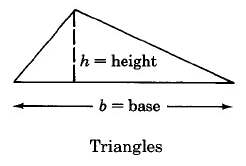
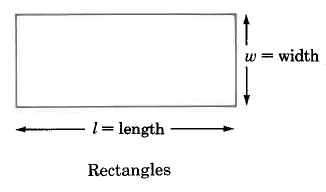
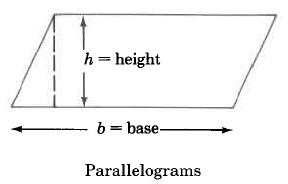
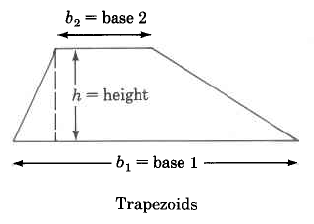
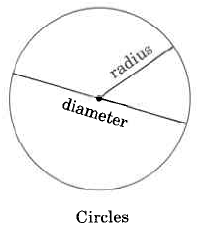
Area Formulas
We can determine the areas of these geometric figures using the following formulas.
| Figure | Area Formula | Statement | |
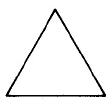 |
Triangle | AT=12⋅b⋅h | Area of a triangle is one half the base times the height. |
 |
Rectangle | AR=l⋅w | Area of a rectangle is the length times the width. |
 |
Parallelogram | AP=b⋅h | Area of a parallelogram is base times the height. |
 |
Trapezoid | ATrap=12⋅(b1+b2)⋅h | Area of a trapezoid is one half the sum of the two bases times the height. |
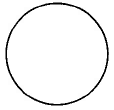 |
Circle | Ac=πr2 | Area of a circle is π times the square of the radius. |
Finding Areas of Some Common Geometric Figures
Find the area of the triangle.

Solution
AT=12⋅b⋅h=12⋅20⋅5 sq ft=10⋅6 sq ft=60 sq ft=60 ft2
The area of this triangle is 60 sq ft, which is often written as 60 ft2.
Find the area of the rectangle.

Solution
Let's first convert 4 ft 2 in. to inches. Since we wish to convert to inches, we'll use the unit fraction 12 in.1 ft since it has inches in the numerator. Then,
4 ft=4 ft1⋅12 in.1 ft=4 ft1⋅12 in.1 ft=48 in.
Thus, 4 ft 2 in. = 48 in. + 2 in. = 50 in.
AR=l⋅w=50 in.⋅8 in.=400 sq in.
The area of this rectangle is 400 sq in.
Find the area of the parallelogram.
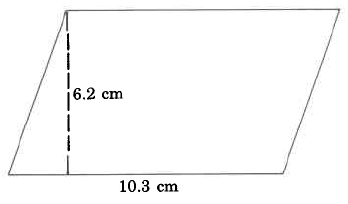
Solution
AP=b⋅h=10.3 cm⋅6.2 cm=63.86 sq cm
The area of this parallelogram is 63.86 sq cm.
Find the area of the trapezoid.
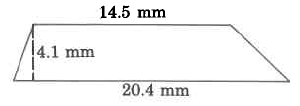
Solution
ATrap=12⋅(b1+b2)⋅h=12⋅(14.5 mm + 20.4 mm)⋅(4.1 mm)=12⋅(34.9 mm)⋅(4.1 mm)=12⋅(143.09 sq mm)=71.545 sq mm
The area of this trapezoid is 71.545 sq mm.
Find the approximate area of the circle.
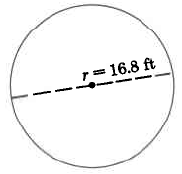
Solution
Ac=π⋅r2≈(3.14)⋅(16.8 ft)2≈(3.14)⋅(282.24 sq ft)≈888.23 sq ft
The area of this circle is approximately 886.23 sq ft.
Practice Set A
Find the area of each of the following geometric figures.

- Answer
-
36 sq cm
Practice Set A
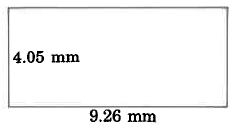
- Answer
-
37.503 sq mm
Practice Set A
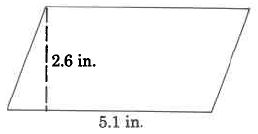
- Answer
-
13.26 sq in.
Practice Set A
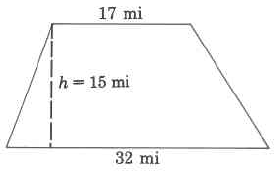
- Answer
-
367.5 sq mi
Practice Set A
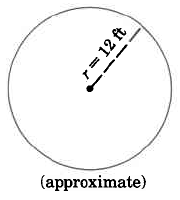
- Answer
-
452.16 sq ft
Practice Set A
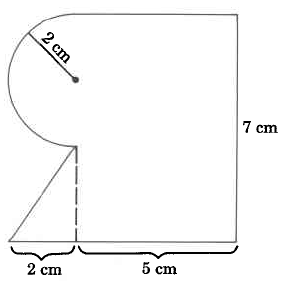
- Answer
-
44.28 sq cm
The Meaning and Notation for Volume
The product (length unit)(length unit)(length unit)=(length unit)3, or cubic length unit (cu length unit), can be interpreted physically as the volume of a three-dimensional object.
Volume
The volume of an object is the amount of cubic length units contained in the object.
For example, 4 cu mm means that 4 cubes, 1 mm on each side, would precisely fill some three-dimensional object. (The cubes may have to be cut and rearranged so they match the shape of the object.)
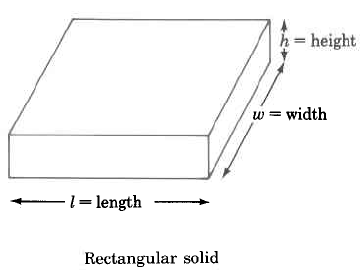
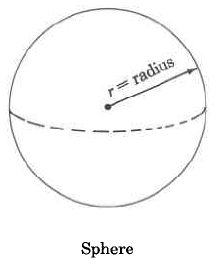
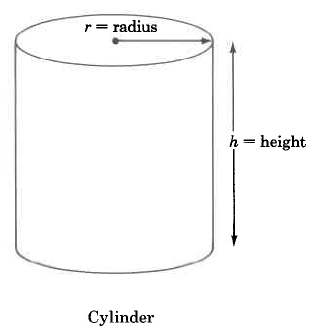
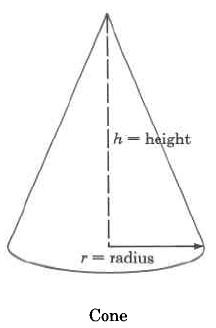
Volume Formulas
| Figure | Volume Formula | Statement | |
 |
Rectangular solid | VR=l⋅w⋅h=(area of base)⋅(height) | The volume of a rectangular solid is the length times the width times the height. |
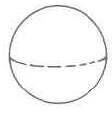 |
Sphere | Vs=43⋅π⋅r3 | The volume of a sphere is 43 times π times the cube of the radius. |
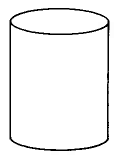 |
Cylinder | VCyl=π⋅r2⋅h=(area of base)⋅(height) | The volume of a cylinder is π times the square of the radius times the height. |
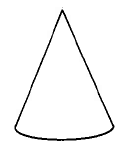 |
Cone | Vc=13⋅π⋅r2⋅h=(area of base)⋅(height) | The volume of a cone is 13 times π times the square of the radius times the height. |
Finding Volumes of Some Common Geometric Objects
Find the volume of the rectangular solid.
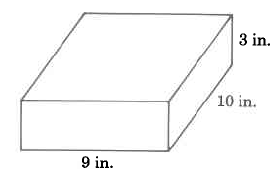
Solution
VR=l⋅w⋅h=9 in.⋅10 in.⋅3 in.=270 cu in.=270 in.3
The volume of this rectangular solid is 270 cu in.
Find the approximate volume of the sphere.
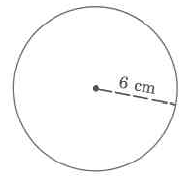
Solution
VS=43⋅π⋅r3≈(43)⋅(3.14)⋅(6 cm)3≈(43)⋅(3.14)⋅(216 cu cm)≈904.32 cu cm
The approximate volume of this sphere is 904.32 cu cm, which is often written as 904.32 cm3.
Find the approximate volume of the cylinder.
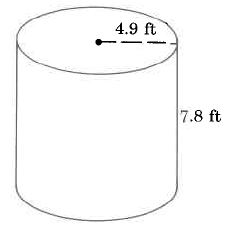
Solution
VCyl=π⋅r2⋅h≈(3.14)⋅(4.9 ft)2⋅(7.8 ft)≈(3.14)⋅(24.01 sq ft)⋅(7.8 ft)≈(3.14)⋅(187.278 cu ft)≈588.05292 cu ft
The volume of this cylinder is approximately 588.05292 cu ft. The volume is approximate because we approximated π with 3.14.
Find the approximate volume of the cone. Round to two decimal places.
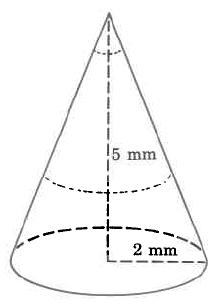
Solution
Vc=13⋅π⋅r2⋅h≈(13)⋅(3.14)⋅(2 mm)2⋅(5 mm)≈(13)⋅(3.14)⋅(4 sq mm)⋅(5 mm)≈(13)⋅(3.14)⋅(20 cu mm)≈20.9¯3 cu mm≈20.93 cu mm
The volume of this cone is approximately 20.93 cu mm. The volume is approximate because we approximated π with 3.14.
Practice Set B
Find the volume of each geometric object. If π is required, approximate it with 3.14 and find the approximate volume.
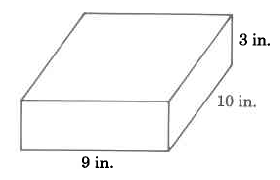
- Answer
-
21 cu in.
Practice Set B
Sphere
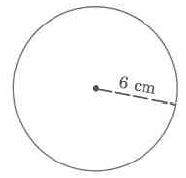
- Answer
-
904.32 cu ft
Practice Set B
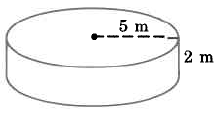
- Answer
-
157 cu m
Practice Set B
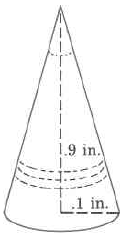
- Answer
-
0.00942 cu in.
Exercises
Find each indicated measurement.
Exercise 9.5.1
Area

- Answer
-
16 sq m
Exercise 9.5.2
Area
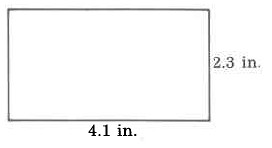
Exercise 9.5.3
Area
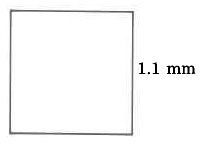
- Answer
-
1.21 sq mm
Exercise 9.5.4
Area
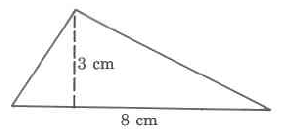
Exercise 9.5.5
Area

- Answer
-
18 sq in.
Exercise 9.5.6
Area
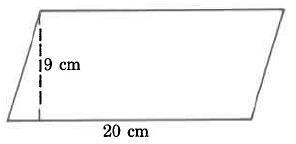
Exercise 9.5.7
Exact area
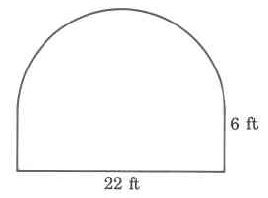
- Answer
-
(60.5π+132) sq ft
Exercise 9.5.8
Approximate area
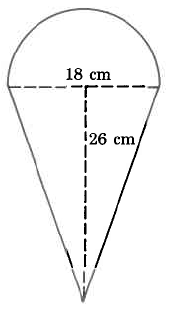
Exercise 9.5.9
Area
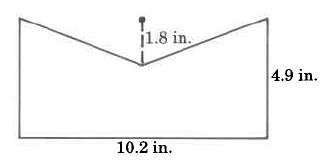
- Answer
-
40.8 sq in.
Exercise 9.5.10
Area
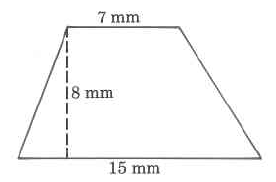
Exercise 9.5.11
Approximate area
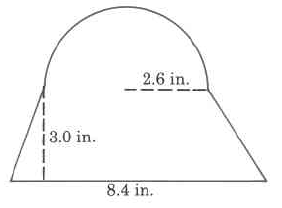
- Answer
-
31.0132 sq in.
Exercise 9.5.12
Exact area
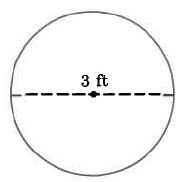
Exercise 9.5.13
Approximate area
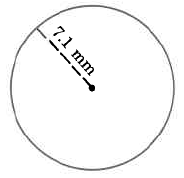
- Answer
-
158.2874 sq mm
Exercise 9.5.14
Exact area
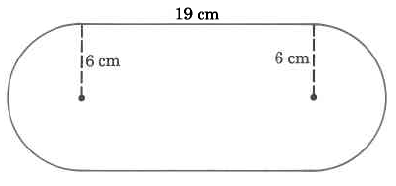
Exercise 9.5.15
Approximate area
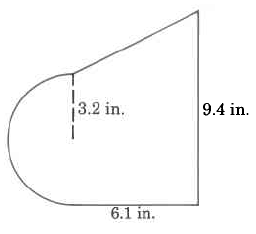
- Answer
-
64.2668 sq in.
Exercise 9.5.16
Area
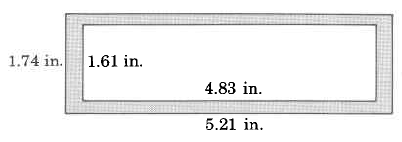
Exercise 9.5.17
Approximate area

- Answer
-
43.96 sq ft
Exercise 9.5.18
Volume
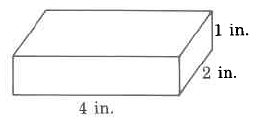
Exercise 9.5.19
Volume
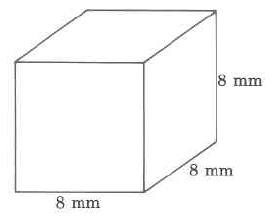
- Answer
-
512 cu cm
Exercise 9.5.20
Exact volume
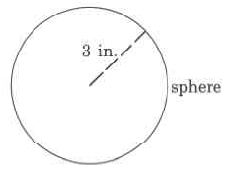
Exercise 9.5.21
Approximate volume
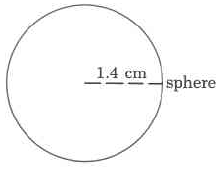
- Answer
-
11.49 cu cm
Exercise 9.5.22
Approximate volume
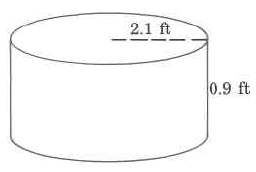
Exercise 9.5.23
Exact volume
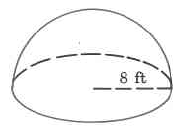
- Answer
-
10243π cu ft
Exercise 9.5.24
Approximate volume
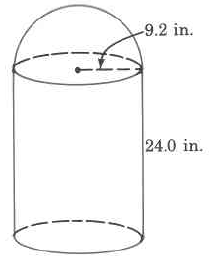
Exercise 9.5.25
Approximate volume
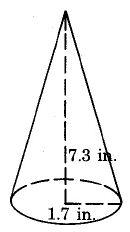
- Answer
-
22.08 cu in.
Exercise 9.5.26
Approximate volume
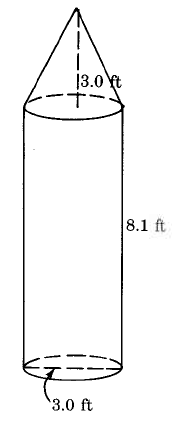
Exercises for Review
Exercise 9.5.27
In the number 23,426, how many hundreds are there?
- Answer
-
4
Exercise 9.5.28
List all the factors of 32.
Exercise 9.5.29
Find the value of 434−356+123.
- Answer
-
3112=2712=2.58
Exercise 9.5.30
Find the value of 5+132+215.
Exercise 9.5.31
Find the perimeter.
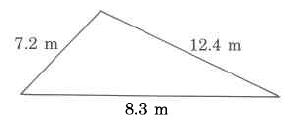
- Answer
-
27.9m


